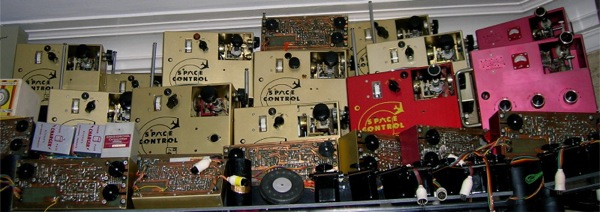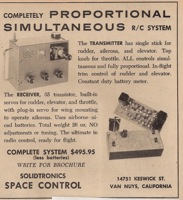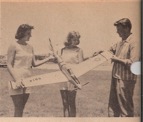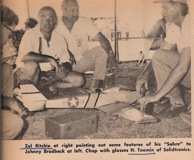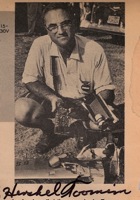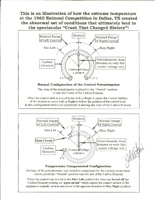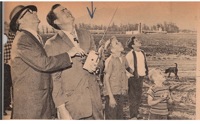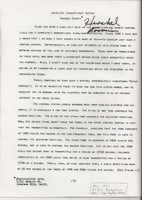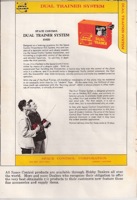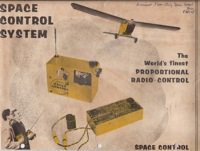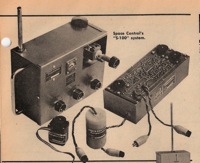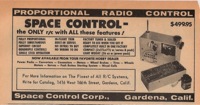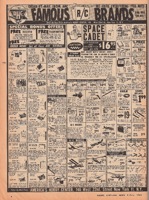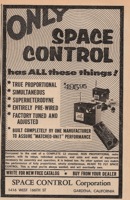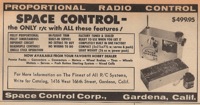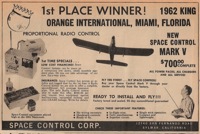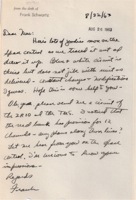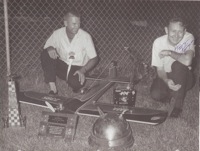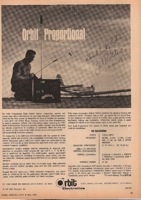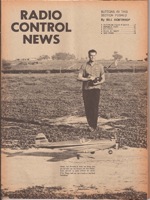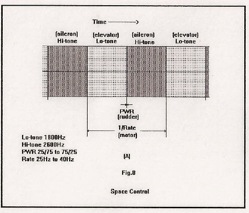Company History:
Space Control
Space Control was the first commercial proportional system. Earlier “proportional” systems had been flying for years, most prominently Walt Good’s TTPW, but these were not full-house or were mechanical or interactive (Galloping Ghost or Kicking Duck) or entailed surface fluttering during normal operations or other limitations. Al Doig’s “Ulti Multi” in 1959 had most of the features of Space Control but was not fully refined and was never manufactured or introduced commercially.
Space Control was announced in the July and August, 1960 editions of M.A.N. and A.M., respectively, with no pictures or advertisements. Given publication lead times this places the actual introduction month’s earlier (est. March 1960). In historical context Space Control appeared a little more than a year after Al Doig’s Ulti Multi, approximately 1 ½ years before the first commercial Sampey (the Command Control / Multiplex), 2 ½ years before the debut of the Sampey 404 and 2 ¼ years before the first Quadruplex advertisement.
Early Proportional Timeline
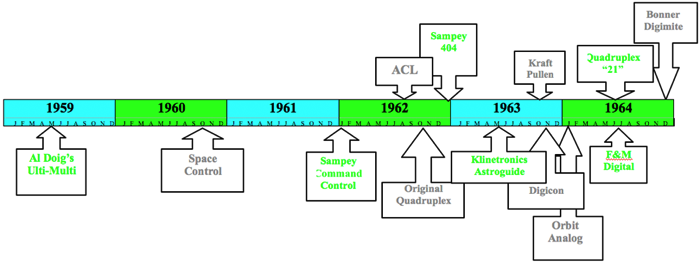
Hershel Toomim Makes History
Space Control was engineered by Hershel Toomim and produced by his company, Solidtronics in Van Nuys, California, a division/subsidiary of Electrosolids Corporation. This was a short and mostly unsuccessful departure into model airplane controls by a company which had much greater success with wider-appeal products including the “Spacephone” walkie-talkie, “Rangerhorn” hand-held electronic megaphone, an early talking doll and perhaps the first desktop electronic calculator.
Electrosolids was formed in 1956 by Joe Strick, Jerry Widawsky and Hershel Toomim. After achieving success in military electronics, Solidtronics decided to try the consumer market. Their “Spacephone” walkie talkie sold for under ten dollars at a time when competitors’ products were priced around $80. It was a runaway success. Hundreds of thousands were sold and Electrosolids issued shares and became a public company in 1960. However, like Space Control, the Electrosolids talking doll (at $120) and desktop calculator ($1,300) proved to be too pricey to reach a profitable level of sales, despite being ahead of their time.
Although financial success eluded Solidtronics in the R/C field, their achievement looms large in RC history. In addition to Space Control, Hershel Toomim can also be credited with designing the first proportional system produced by a “big established company”. Orbit Electronics was probably #1 in the world at that time. Orbit’s long-awaited first proportional system used the Space Control circuits and designs. It was essentially a Space Control with a transistorized transmitter and separate servos (i.e. not incorporated in a brick).
Although he was a modeler, Toomim’s business interests had nothing to do with model airplanes or radio control and he developed Space Control independently. He says he was not influenced by, and did not build on the foundation of, pioneers like Walt Good and Al Doig and was not aware of their systems until after Space Control was flying.
Coincidentally, the same July 1960 magazine which announced Space Control also announced “Ritchie’s Power Packs” and chargers said to be “widely used” on the “West Coast”. Zel Ritchie would later become “Mr. Space Control” in the public eye and ultimately be involved with the system far longer than Solidtronics or Toomim. His involvement came very early, perhaps near the beginning. Although he was an electronics expert in his own right and subsequently modified the system, we don’t believe he was involved in the initial design. However, as early as the January 1961 Flying Models review it was stated that Zel Ritchie developed a power converter enclosed in the Space Control “brick.”
Here is the new product review from the January 1961 edition of Flying Models:
“Space Control is a new Quadruple Simultaneous Proportional control recently introduced by Solidtronics Division of Electrosolids Corp. of Van Nuys, California. As you may well imagine this is about the closest thing to being in the cockpit yet devised.
Without going into a complete technical shakedown we will outline the rig in lay language. Basically the circuit, designed by Hershel Toomim, is a form of mulit-plax which, in effect, allows the transmission of four commands simultaneously without interaction or interference to one another.
****According to Hershel with whom we had a long conversation recently, this is the end result of 15 years of dreaming and almost three years of final testing. The system has been wrung out, survived crackups and given the final count down. Now it’s ready for the public. As you might imagine, this complete system will put quite a load on the budget and will probably hit the market at about 5 bills! Let’s hope mass production can bring it into reach of many flyers.”
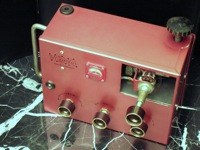 | 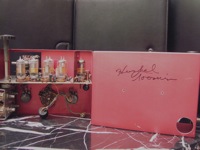 |
How It Worked
The following is a brief overview of how Space Control worked, from Hershel Toomim’s submission to the DCRC in May, 1961. It was basically a two-tone system but with the “unique feature of transmitting the tones alternatively”. The pitch of one tone controlled the ailerons, the other the elevator. The repetition rate was varied to achieve throttle control and the symmetry or time-sharing between the two tones was changed to control rudder.
These two varied audio tones were picked up by a transistorized superhet receiver and then put through a limiter. This limited amplitude variation, so control response would not vary with distance from the plane. After this limiting, the signal was decoded to obtain DC voltages used to control feedback type servos to activate the control surfaces. The servo employed a micro-mo motor with a built-in gear ratio of 59:1, and an amplifier containing an adjustable resister which enabled the motor itself to provide “damping” for smooth, quick control without using a DC generator or resistance – capacitive circuit. See “More Technical Information” below for additional details.
The First Ads
Here is the first ad we have found for Space Control; October, 1960, MAN. This was a complete system freeing the buyer from having to find compatible components like receivers or batteries and even coming pre-wired. Complete systems were still not common then. This one went further by mounting three of the four servos in an integral case along with the receiver and airborne batteries. This integrated airborne unit became known as the “brick” due to its shape and size, the red color of early units and, to a lesser extent, its weight (at 26 ounces, actually not bad for those days).
This system answered the Third Dream of Radio Control. It offered full-house simultaneous proportional in a complete package. The only drawbacks were its price, $550+ with batteries (equivalent to about $4,000.00 in 2007 dollars) and reliability problems (e.g. neutral drifting) common to pioneering systems. Here is the second ad for Space Control with additional details. Hershel Toomim added his signature to this ad 46 years later for our encyclopedia.
Pentagon Air Show
Electrosolids Corp. also attempted to sell Space Control to the military for use with reconnaissance and target drones. Their Washington representative arranged a demonstration for top brass. Incredibly, we are told the demonstration flight was conducted in the very center of the Pentagon itself, the Pentagon’s park-like central courtyard. No orders were placed, however. Toomim believes they already had radio control equipment which was better in at least some respects, but at much greater cost which did not deter the military.
It is hard to believe a sizeable glow engine powered model would have been allowed to fly in the center courtyard, even back then, and the necessary maneuvers would have been challenging at best. Perhaps it was demonstrated in an empty Pentagon parking lot after hours. The source of this account is highly credible, however; please contact us if you know anything about this.
Zel Ritchie Arrives
Toomim needed a top flyer to demonstrate and promote his system. Toomim met Zel Ritchie at the local Sepulveda Basin flying field and was very impressed. It was hard not to be impressed by Zel Ritchie. He was one of the greatest model airplane pilots of all time and was widely regarded as a likable down-to-earth modeler.
His skill level was so high that he disconnected the stick centering springs on his Space Control (which return controls to neutral) and flew entirely by feel. You might suspect that an additional reason for this was the tendency of Space Control and other early proportional systems to drift so spring centering would return the control surfaces to the wrong neutral and require trim adjustments. Indeed, this problem, exacerbated by abnormal heat conditions, lead to his crash at the Dallas Nationals (see below) which he still considers “one of the worst disasters of my life”. However, Zel says that drifting was not why he disconnected the springs and points out he had no springs on his prior transmitter, a TTPW, or on the J-3 Cub he learned to fly on.
Zel Ritchie met Walt Good and Maynard Hill while stationed in the DC area and had been flying Good’s TTPW proportional system for years. Zel “bonded” to Space Control the first time he flew one since its stick control felt just like they full size J-3 cub he learned to fly in. He found that it gave him the ability to do maneuvers that no other contest pilot could do. For example, using Space Control and a special airfoil he designed he was able to fly the entire contest pattern upside down. Zel believed this was the great advantage of proportional and truly enjoyed living the Third Dream. He never lost faith in the system and always believed it was the best. His promotion of Space Control was not hype or salesmanship. It was true conviction.
Space Control had its first public test at the July, 1960 nationals, about the same time its announcement appeared in magazines. Things could have gone better. Designed in temperate California, this system was not prepared for the 110 F heat of summertime Dallas. This heat, which some say measured 130 on the runway caused Space Control to misbehave, with servos wandering away from their proper position. To counter this, they packed dry ice into the plane. This reduced the temperature and worked for a while but ultimately lead to a spectacular crash. Upon impact the sublimating dry ice gave off vapors which everyone perceived as clouds of smoke billowing out of a burning wreck.
The Crash That Changed History
Radio Control history was forever altered by this crash. Had it not occurred, had the dry ice continued to work, had the Nationals been held in California, New Jersey, Illinois or another more temperate locale, R/C history would have changed. It is difficult to comprehend how huge the impact would have been had a proportional system won the Nationals (or placed high) back in those days when reed systems ruled. At a minimum, many more Space Control systems would have been sold and RC developers would have moved more directly into proportional.
Here is Hershel Toomim’s account of the Crash that Changed History, from his letter to us in the Encyclopedia of Radio Control:
“The Space Control Model Airplane system provided proportional control of four independent variables assigned via servo motors respectively to ailerons, rudder, elevators and throttle. The elevators and rudder were frequency controlled and detection was via tuned frequency circuits that required very small capacitors for frequency determinations. These capacitors were temperature sensitive which was quite satisfactory in the mild weather in Los Angeles. In Dallas, Texas Contest day was blazing hot.
Zel Ritchie was an expert pilot, the finest I had ever met. Naturally I chose him to fly in the Nationals. In our last test flight that morning our plane looked and sounded so real as it taxied under complete precision control out to the runway, took off, and climbed to altitude. Zel’s aerobatics were flawlessly smooth. Entering the final spin and recovery it was a thrill to watch that after exactly three rotations his recovery was flawless. We were satisfied. We knew there was nothing to match this beautiful performance.
Zel learned something that morning.As an accomplished pilot he didn’t need the springs that returned all controls to neutral if the stick was released. He wanted those pesky amateur things removed. Without foreboding or objections I immediately removed them.
We are in the preflight tent. Awaiting our flight time, with mounting excitement we watch the slam bang relay systems perform with their characteristic limited maneuverability. Zel and I know the smoothness of proportional control will ace them all. Early that morning we had our last test flight with Zel’s beautiful low winged Sabre. His smooth coordinated control was a clear winner. It is getting warmer under the tent, a bit uncomfortable, our excitement continues to climb. I check and recheck our controls.
Everything is go. I notice a bit of displacement of the elevators, easily corrected with a slight adjustment of the elevator centering control on the transmitter. The day wears on, noon is approaching, another check shows the elevator and the rudder are also displaced. How can that happen? This system has had many flight hours. Nothing like that has ever happened before, something is awry. The heat is awful. I, as a born Texan, know I can stand it but can that Los Angeles born Sabre stand it? Maybe the heat is behind the offset rudder and elevator. Another check shows everything is going cattywampus. It has to be the heat. What can I do about that? A cold drink? Welcome for me but not for an airplane! Dry Ice, that’s the ticket. Now where can I get that? In Dallas, on Saturday? Well, maybe but where? Not near here. I ask Zel, “Where can we get dry ice?” “We also need a car to even look.” Zel disappears, I’m left alone with the problem. I don’t know anybody here. How can I borrow a car? Time is wasting. Zel has been gone a long time but here he comes now with a big smile. He has found a car, a Ford coupe V8. The search is on!
I take off in the Ford. It’s fun to drive. Right over there, looks like an icehouse. Yes, they have dry ice. Salvation is near. With several pounds, I return the 19 miles to the airfield. It’s hotter than ever. With sweat pouring in my eyes I removed the wing and pack the Space Control with the life cooling dry ice. The controls begin to drift back through neutral. I watch them slow to a final position and stop firmly. Their position is easily corrected with the control knobs on the transmitter. We are ready to fly. We still even have time.
Again, my excitement mounts. This is going to be great!! Zel looks cool as a cucumber, unflappable, the ultimate flyer, ready for whatever happens. Now we are next. I can’t even watch the competition. My mind is full of solutions. Zero temperature coefficient capacitors. Are they small enough to fit? My reverie is ended by the sound of the engine. Zel is taxiing out to the runway. It is our time!! He wastes no time, gives it the gun and swoops ever so smoothly into the air, circles the field, slowly gaining altitude just for the show. That plane can out climb any plane here. The smooth sound of the engine is music to my ears. With Zel at the controls we can’t lose.
Lazy eights, inside loops, outside loops, Immelman turns, all so smooth, all so precise, in awe I watch perfection in the sky. Now for the final spin. The Sabre gains speed then begins the pull up following its own silken thread as it slows to its final stall as Zel cuts the throttle slowly just to show off, I think. At the zenith, a stall, full right rudder, it falls into a spin as preprogrammed. Three turns, headed straight down, its time to pull out Zel comes out inverted! Without much altitude he circles the field gaining altitude inverted. Right in front of the crowd he heads down in a vertical dive.
The crash is spectacular, enveloped in white smoke, I calculate 60Gs to stop it”.
Here is a picture of Hershel Toomim at the end of that fateful day. Does he look like his dreams crashed that day with the Sabre? Perhaps. In any event he left the business just six months later.
A prominent flyer at the Dallas Nationals remarked that this was the death knell for proportional”, to some considerable agreement. The press was less negative. Grid Leaks noted that Space Control was “engineered thoroughly from stick box to servos” and “beautifully fashioned,” “showed great promise for future development” and will be “a thing to be reckon with in the foreseeable future”.
American Modeler noted that despite “teething troubles” there was one flight that showed the possibilities of the equipment including “beautiful” performance and “extremely smooth” control. Another commentator referred to its “one fine flight” and concluded that future development of Space Control “will be followed with much interest”
Despite the violent crash, the Space Control system was undamaged and fully functional. This enabled tests to determine cause of crash. Zel Ritchie discovered that the left rudder command necessary to exit the final right spin produced full right rudder. This disastrous reversal of controls resulted from physically turning the potentiometers to compensate for the heat induced drift. This turn left only a sliver of left rudder function, enough to fool Ritchie in the preflight when he moved the rudder only a bit to confirm it was operating properly. However, when 30% or more left rudder was commanded, the wiper would go off its contact points in the pot, creating an open circuit and automatic full right rudder.
Zel Ritchie Takes Over
Not long after the Disaster in Dallas, Hershel Toomim lost interest in Space Control. He says he “wasn’t doing anything with the product and Zel Ritchie simply picked it up and decided to make a go of it”. Electrosolids Corporation gave its Solidtronics stock to Zel Ritchie, without charge, and he became the new owner of Solidtronics. Zel gave up his engineering job and went full time into the RC equipment business.
In the February / March 1961 issue of F.M. it was announced that “Zel Ritchie has acquired the rights to Solidtronics Space Control and will continue to manufacture these units as well as his power supply items, under the Space Control banner”. An article in the April 1961 A.M. disclosed that “Space Control Corp., Gardena, California, will manufacture and market the Space Control equipment developed by Solidtronics. Heading new concern will be Zel Ritchie active R/C flier well known in R/C circles on East and West Coasts”.
Product Promotion
Zel changed the name of Solidtronics to “Space Control Corporation” (or adopted that name as a dba). He used Space Control Corporation to handle both Space Control and his other equipment and began to travel the country to demonstrate Space Control in hopes of spurring sales. He donned a suit and was photographed helping the Mayor of Los Angeles fly Space Control at a ground breaking ceremony. He put the system through its paces at the May, 1961 DCRC Symposium and submitted a technical paper on Space Control by Hershel Toomim.
Like other RC manufacturers Zel may have placed his product with leading flyers to aid its promotion and increase the chances of a sales-boosting contest victory. These may have included Hal DeBolt, Bob Heise and Chuck Boyer. We do not know if he sold them Space Control systems at a discount or gave them Space Control without charge to further this objective.
In the April/May 1961 A.M. radio control Guru Howard McEntee called Boyer and Heise “the lucky bums” for getting to test fly this “Red Brick” state-of-the-art system, and then made the following, clear-sighted prediction:
“Prediction: a proportional set-up like Space Control is the type that we will all be flying in the future.”
Zel Ritchie personally test flew each Space Control system before delivery to “make sure everything was ok”. For this purpose he built a special test plane “too crude and too ugly” to be photographed.
Third Hurdle
In his efforts to promote Space Control, Zel Ritchie had to overcome more than merely its huge price and reliability issues. The third hurdle was hostility from “establishment” flyers. When Zel first flew a Walt Good TTPW at his California flying field the ridicule he suffered was so severe, (making fun of its gyrating tail surfaces, etc.) that he felt obliged to buy a reed system if he wanted to keep flying there. Also experienced by Don Brown (see Quadruplex history) and other proportional pioneers, this unrelenting peer hostility was partly jealousy, partly fear that the countless hours reed pilots had invested to master aerobatics with these systems could be wasted if reeds were trumped by a better technology and partly the human tendency, not confined to the high school years, to make fun of anything different.
In Zel’s southern California location there was another factor, especially when he showed up with the superior Space Control system. Many of the leading flyers were themselves RC manufacturers or their employees, suppliers or friends. Space Control presented a competitive threat and this no doubt accounted for some of the hostility and resistance Zel encountered.
Space Control Corporation
Space Control Corporation sold a range of accessories, including Ritchie Rechargeable Power Packs, wheels and brakes, connectors, millimeters, starting systems, converters and chargers. Space Control systems were guaranteed 90 days. The address of Space Control Corporation was in Gardena, California the same as Ritchie’s Electronic Products before it. However, the cover of their early catalog says “Space Control Corporation, a division of Electrosolids Corporation”.
 | 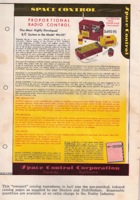 |
This suggests Electrosolids still had some ownership and control interest. This catalog was in the early, transitional period of Space Control Version 4A, described below, and Ritchie may have taken over 100% shortly thereafter. If Solidtronics owned Space Control it would normally be referred to as its “subsidiary” not it’s “division”. It is also possible Solidtronics’ name was changed to Space Control Corporation before Electrosolids gave it to Ritchie. A minor mystery. Zel recalls he added this line to the brochure as a courtesy to Hershel Toomim to give him some credit.
Another mystery is the identity of the “student” in the Space Control Dual Trainer pictures. Here is the picture from the early catalog and from the cover of a Space Control box. This was autographed by both Ritchie and Toomim since the student could very well be Toomim but no one is certain of this (not even Hershel Toomim).
Here is a different view of the two of them evidently shot just before the mystery picture, as it appeared in the April, 1962 A.M.
System Modifications
After taking over, the first changes Zel Ritchie made to the system were to install output wheels instead of levers on the servos, place a “Space Control Corporation” plaque over the “Solidtronics” name in the upper left corner and “Space Control” plaque under the meter. The latter 2 changes were cosmetic and signified the change in control. The output wheels enabled differential displacement of control surfaces by attaching the pushrods to different points on the wheels. Here’s how the system looked after these changes (Version 2 or “S-100”)
Zel’s next change was to move the two trim knobs from the face of the transmitter to the upper right hand side. This facilitated in-flight trim adjustments without having to remove one’s right hand from the stick. Here’s how this looked (Version 3).
Zel’s next set of changes were more extensive and produced the final and most familiar “Space Control” appearance (Versions 4A and 4B):
1. The power/filament control was moved to the top of the case and changed to a pointer knob. This opened up space in the lower part of the transmitter to accommodate the new Ritchie Pack battery (see below).
2. A vertical “Space Control” brand meter was placed to the left of the pointer knob, replacing the old red plastic Aristocraft brand meter.
3. An indicator light was added above and to the left of the pointer knob to indicate when the charger was operating and also served as a fuse. This was above and to the right on an interim Version (Version 4A). Version 4A was depicted in ads from April-June 1962. Shown below is its first appearance, in the April, 1962 A.M. product announcement. Also shown below is how Version 4B looked in all ads from July 1962 until the end (last ad Mar/Apr 1963).
4. The gimbal and stick assemblies were substantially redesigned, switching from a “post and L” gimbal to a “dual L” configuration with the stick protruding less.
5. The large “swooshing jet” Space Control logo was applied by silkscreen (or sometimes with a plaque on Version 4A) on the left lower face of the transmitter. Amusingly, this logo included the symbol for the transistor, while inside the case were 8 vacuum tubes.
6. The style of the knobs was changed.
7. The first models had red anodized aluminum cases (like the initial Solidtronics version) until the carry-over stock of these was used up. Subsequent models had gold anodized cases, although a few still had red gimbal blocks until these were used up.
8. Aside from case color and output wheels, changes in the receiver “brick” included the redesign of the RF end to improve range and selectivity, replacing the two sockets with cables and separate connectors to remove connections from vibration of brick attached to airframe and a major redo of the circuit board to accommodate the foregoing and add the Space Control logo and a box for serial numbers.
9. Within the transmitter Zel replaced the A and B dry batteries with a rechargeable NiCad “Ritchie Pack”. This incorporated a converter to step up voltage previously provided by the B battery and a built-in charger with extension cord to plug into household outlets.
10. A possible fifth version was the “New Mark V” introduced in November 1962. It was said to have “many important improvements” including “temperature stability and sealed potentiometers on critical controls.” However, this may simply be Version 4B, the fifth iteration in our Space Control classification. As you can see from this ad in the November 62 A.M. its outward appearance is the same.
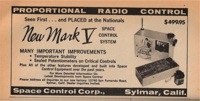 | 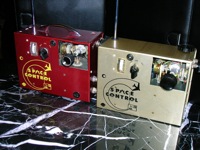 |
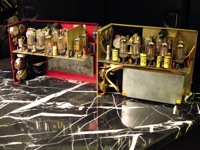 | 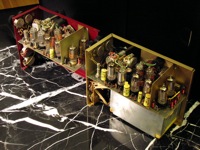 |  |
Total Produced
Very few of Versions 2, 3 and 4A were ever produced. These were transitional and we are not aware of any Versions 2 or 3 still in existence. Both Zel Ritchie and Hershel Toomim insist that less than 100 Space Controls were ever sold. Since it is human nature to exaggerate the size of past accomplishments this “less than 100 ever made” assertion has powerful credibility. However, memories fade with time, and, based on the number of Space Controls known to exist in our collection and others, we estimated perhaps 40 were made before Zel Ritchie’s takeover, and 90 after that for a total of at least 130, or more.
Changing Ads
An unusual advertisement with a yet-to-be-discovered story behind it appeared in the June 1962 MAN. America’s Hobby Center was famous for its multi-page ads featuring affordable RC and other hobby supplies targeted at the “common man”. Radio control systems promoted by AHC in June, 1962 ranged from $16.95 to 119.50 with an average price of about $50, except, that is, for one. AHC’s June 1962 ad included a Space Control system for 495.95. This ad was repeated in the next month but never appeared again.
We wonder if AHC discontinued Space Control after experiencing poor sales (average hobbyists could not afford the equivalent of $4,000.00 in today’s dollars)? Perhaps there is more to the story.
Space Control tried to address the price problem. In this April 1962 ad, for example, they pointed out that their system was complete and was not expensive compared to the alternative top-of-the-line system back then – 12 channel reeds – because so many separate items needed to be purchased to make the typical reed system complete.
Here is a typical late-model Space Control ad from the August 1962 A.M.:
Here is the variation which was the first with the Sylmar, California address, discussed below (October, 62 A.M.)
To add to the confusion, this small Gardena, California ad ran from July 1962 – December 1962, overlapping the Sylmar, California ad for 3 months. This was a 6 month pre-purchased advertisement.
In the final ads (last 6 months) the address of Space Control Corporation was changed from Gardena to Sylmar, California. This evidently reflects Zel’s move of the business to less expensive quarters after the financial difficulties discussed below. These ads also referred to the product as the “New Mark V”. The last 2 ads jumped the price from $499.95 to $700.00. This is odd given the emergence of more advanced, lower priced competition. It may have been a last ditch attempt to generate sales by making quality seem higher (you get what you pay for). The only reason Zel recalls for raising the price was to overcome his financial difficulties at the time.
Oddly, these ads touted 2 “improvements”, sealed potentiometers and temperature stability, which had already been made some time before. Temperature stable capacitors were introduced by Hershel Toomim back in 1960 right after the (temperature induced) Crash That Changed History. These ads also introduced time payments, lay-away and C.O.D. payment plans (similar to final Sampey 404 ads years later) in an attempt to overcome the huge financial obstacle to ownership and even offered crash insurance. Thus, these finals ads departed from Space Control prior practices in size, price, address and content.
The second to last ad was a full page. This was the first and last time Space Control had a full page ad. Here’s how it looked:
Industrial Espionage
While imitation may be a form of flattery it is seldom welcome in business. We suspect many companies reverse engineered this ground breaking, but unpatented, system in search of a shortcut to their own successful proportional. Some may have even considered it negligence not to do so.
Here’s an example of this flattery. This letter was written to the head of Citizen-Ship, Vernon MacNaab. He was often called Mac by close associates.
Financial Problems
After overcoming the technical problems which held Space Control back at the 1960 Nationals, Zel Ritchie had to pass up his chance for redemption at the 1961 Nationals. He simply couldn’t afford to attend given the location in Philadelphia, across the continent. Ironically, Zel would be denied first place at a subsequent Nationals by another gifted RC pilot who also could not afford to travel to the contest (see Bomb is Dropped, below).
At the 1962 Nationals Zel won third place in pattern and tenth in pylon. Upon his return Zel discovered that his accountant had forged checks, stolen his credit cards, cleaned out his bank account and then vanished. Space Control never fully recovered from this financial devastation.
Fateful Victory
Sometimes life takes strange twists.
Space Control won the King Orange Internationals held at Valparaiso, Florida in March 1963. The winning pilot was Jim Kirkland flying a low wing original designed especially for proportional. He called it the Beachcomber. The proportional he used at the King Orange was Space Control. This was the first place major-contest win Space Control had been waiting for to help promote sales. As good as this day was for Space Control, it ironically sowed the seeds for Zel Ritchie’s bitter disappointment at the subsequent 63’ Nationals.
On that day at King Orange, the victorious Jim Kirkland met another local Floridian who owned a radio control business. His name: Harry Sampey.
Bomb Is Dropped
By the time of the 1963 Nationals Zel Ritchie knew his day had come. He was sure he could beat any competitor-coast-to-coast despite the fact that his Space Control was now middle-aged (for electronics). He was nearly right. He won first place in pylon racing. In the more important general aerobatic category he surpassed every other pilot and radio control system from every place in the country. Except for one.
Not even Zel Ritchie was prepared for what landed under cover of darkness in a multi-million dollar United States Air Force jet bomber the night before the Nationals. Hidden in the B-57 Bomb bay that night at Los Alamitos Naval Air Station were 2 secret weapons – a Beachcomber model airplane and a Sampey 404.
Armed with these weapons, Master Sergeant Jim Kirkland beat Zel Ritchie to win the 1963 Nationals, and history moved forward into a new era.
Orbit Takes Over
In the August, 1963 MAN it was announced that “orbit has bought out Space Control” but will not market it until “certain modifications have been made”. Orbit said it would service existing Space Control equipment from now on. Orbit’s first proportional used the Space Control circuits and was actually called “The Orbit Space Control” by commentators prior to its introduction.
Like Electrosolids Corp. before him, Zel Ritchie received no payment when he transferred the rights to Space Control. He did get a job at Orbit and worked there for 2-3 years afterwards. Zel found it very humbling to go to work for a competitor after being the captain of his own ship; but employment at Orbit gave him a steady income to support his family and a chance to continue RC flying at the highest levels.
Orbit Salutes Ritchie
In something of a final tribute to Zel Ritchie, Orbit ran full page ads for its long-awaited first proportional system. Orbit had a reputation for quality and was probably the number on RC manufacturer in the world at that time. Everyone knew that entry into proportional was inevitable but fraught with danger. Phil Kraft, whose company would later eclipse Orbit and all others, lamented as late as May 1964 that it seemed impossible to produce a quality proportional system for the mass market. Some months after the Orbit proportional debuted, RCM ran a controversial review containing some negative comments on the system and predicting digital proportional would prevail over analog systems like Orbit. This was a major blow to Orbit, threatening the future of Orbit Proportional.
Everything was on the line, and Orbit rolled out a “romantic” full page ad of a flyer at sunset using Orbit’s proportional. The picture showed one airplane and one pilot without identifying them. There was no need for identification. The airplane was Zel Ritchie’s Phantom. The pilot was Zel Ritchie.
Any doubt about the identity of the pilot and plane in the fading light was resolved by the following full page daylight picture of the two of them in the October 65 MAN.
Ad’s Other Secrets
In addition to the identity of the unnamed pilot, Orbit’s full page “flyer at sunset” ad harbored four other secrets, some truly incredible:
1. The featured Orbit proportional transmitter in the foreground was not actually present, it was superimposed on the original picture to make the ad.
2. Unknown to the public or virtually anyone else, whenever Zel Ritchie flew the Orbit proportional his airborne was pure Space Control – a space control brick. Thus for example, in the above full-page Orbit advertisement and publicity photo the Phantom airplane contained no Orbit receiver or servos, only a Space Control brick. This was also the case when Zel flew the Orbit proportional to win 2nd place in pattern and 1st in pylon at the 1964 Nationals.
This practice and interoperability underscore how the Orbit proportional was actually a Space Control system and why it was initially referred to as the “Orbit Space Control”. Orbit’s improvements to Space Control were important but relatively minor. First among these was converting the transmitter from tubes to transistors, something Zel had long wanted to do but lacked the funds necessary for redesign and retooling.
3. If the irony of non-Orbit equipment in an Orbit ad isn’t enough for you, how about this? Minutes after the ad picture was taken the airplane was destroyed due to loss of radio control. Advertise that! We suspect Orbit did not know this at the time the picture was selected since the risk of embarrassment and reputation damage would have been too great if word ever got out. Zel believes the crash was not the fault of the Orbit (or Space Control) equipment at all; he says the plane appeared to be shot down by radio interference. He even speculates it could have been military jamming equipment since the unusual flying site used that day was next to a military base and not a location where anyone else was known to fly models before or since.
4. To top it all off, this disastrous crash just minutes after Orbit’s famous ad was photographed led to the end of Zel Ritchie’s involvement in model aviation. The destroyed plane was a special Phantom he built to compete in the 1965 Internationals in Sweden. He had to use a back up plane, and put the crashed Fox 59 in it since it seemed to survive the crash alright. In Sweden the engine failed twice dropping Ritchie from 1st place (or near 1st) to 5th. Zel was so devastated by how many things could deny him a victory which had nothing to do with the control system, the airplane or his flying, that he quit model airplanes completely and cut off all contact with anyone related to RC flying for 41 years! He did receive one communication – the report from Fox’s owner Duke Fox about why the engine failed at the Internationals. It had a slightly bent crankshaft from the crash at sunset right after the Orbit ad was photographed.
Additional Technical Information
By: Carl Schwab
The multiplexing scheme used by Space Control was as hybrid; it was TDMA and FDMA. The servos used a coreless motor, were quite small, but were subject to vibration damage if used with anything bigger than a 60 size engine. The packaging of Space Control was novel. The airborne unit i.e. receiver, rudder, elevator and throttle servos were mounted in a single unit referred as the Red Brick. The dimensions for the Brick were 2”x3-1/4”x7-1/2”. The aileron servo was a separate unit. Airborne weight was 26 ounces including battery.
The transmitter used a 3-axis single stick located in the upper right-hand corner of the box; throttle control was right hand top of the box. Trims were on the right side near the top of the box. The box was 7” H x 10”W x 4”D with the telescoping antenna out the top. Two trims were provided; aileron and elevator. No trim was provided for the rudder or throttle.
Fig8A illustrates the multiplexing plan. The elevator and aileron tones were sent alternatively and their frequency varied independently for servo commands. The elevator and aileron channels depended up on Track&Hold feature in the 2-coil discriminators (actually radio detectors) to maintain a servo signal while the other tone was transmitted. The scheme is TDMA in that the subcarrier tones, though different frequency, were NOT sent at the same time. The Track&Hold requirement put a limitation on the maximum excursion of the PWR for rudder. As I recall, if you held say full left rudder, then full aileron throw either direction was difficult whilst full right rudder caused elevator to have reduced full throw. This was more of a nuisance than anything else. The units seemed to be temperature sensitive in that the trims on aileron and elevator would change as temperature changed. Rudder seemed pretty solid most of the time but throttle could wander a bit for no reason.



